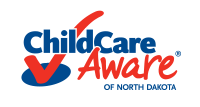Choosing and Using Curriculum
Research shows that quality of care is enhanced when a purposeful curriculum is incorporated into a child care setting. A well-planned, written curriculum includes:
- The content that children are to learn
- The experinces/processes through which children achieve the identified goals
- What child care providers/teachers need to do to help children achieve these goals
HAVE A QUESTION?
Contact an Early Learning Consultant: 800-997-8515
Submit a question or request individualized support ➜
Factors to Consider When Choosing a Curriculum
-
Evidence-Based
Describes the theory and/or child development research used in the development of the curriculum.
-
Goals and Objectives
Provides developmentally appropriate goals and objectives that align with the North Dakota Early Leaning Guidelines and reflect the program's philosophy.
-
Schedules and Routines / Intentional Teaching
Includes guidance on developing an age-appropriate schedule that is predictable but flexible and is responsive to the needs of individual children. Routines such as feeding or toileting are included as an integral part of the children’s schedule and learning as age appropriate.
-
Set-Up of Physical Environment
Provides guidance for the set-up of the physical environment (room/home space arrangement, furnishings, and equipment) and its link to learning.
-
Developmentally Appropriate Materials and Experiences
The materials and experiences used in the curriculum
- Link to the goals and objectives for children’s development and learning
- Include a variety (3 or more) of instructional formats and strategies (example: child-initiated, adult-initiated, large group, small group, activities, and learning centers)
- Include a variety of the children’s senses (sight, touch, smell, taste, hearing)
- Materials are play-based and open-ended
- Present concepts that are concrete and relevant to children’s everyday lives
- Flexible enough to promote learning in both indoor and outdoor settings
- Support children in making choices -
Social-Emotional Environment
Provides appropriate guidance on how adults can facilitate children’s social-emotional development through interactions and peer relationships.
-
Diversity
Supports the development and learning of children from diverse backgrounds, addresses how adults can provide experiences that are culturally relevant and reflects a variety of cultures, languages, socio-economic status, and structures.
-
Inclusive of Children with Varying Abilities
Includes provisions for modifications/adaptations to include children with special needs, children who speak languages other than English, gifted children, etc.
-
Family Involvement
Promotes two-way communication and includes ways to collaborate with families through a shared decision making process.
-
Implementation Guides
Explains how to implement the curriculum and offers resources and tools to evaluate the extent to which the curriculum is implemented as designed.
Curriculum Resources
-
This online Curriculum Consumer Report provides review summaries and ratings of comprehensive infant and toddler, preschool, and home-based curricula.
-
Developmentally appropriate resources that help foster the growth of the whole child—cognitively, physically, socially, and emotionally.
-
Publisher of books and resources that assist teachers in providing a stimulating, child-centered curriculum based on sound and accepted theory.
-
Publisher of books and resource materials covering all areas of education from infant/toddler to adult learning.

